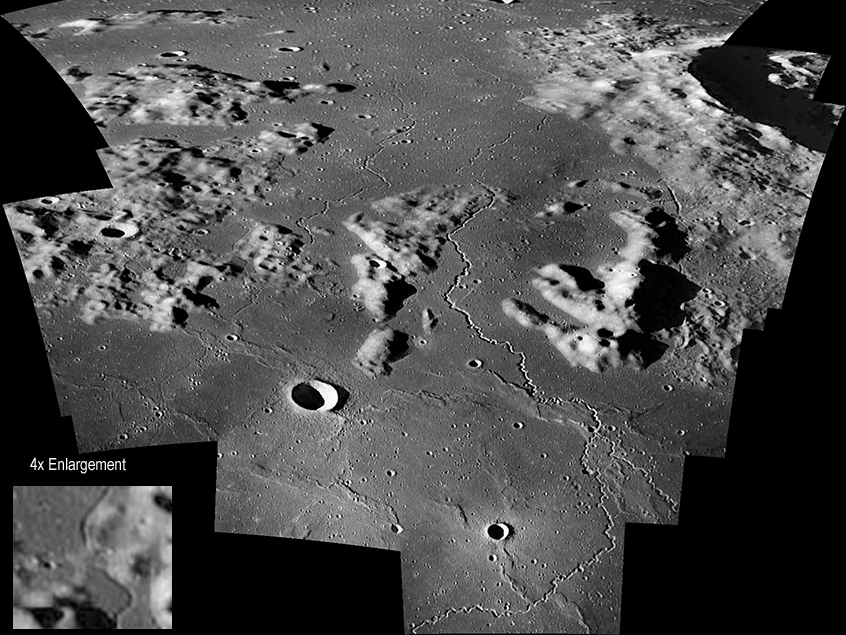Apollo 16 images mosaicked by Bob Pilz. South up.
Few rilles are as dramatically imaged as these in southern Oceanus Procellarum that meander south into Mare Humorum. This is the view savored by Apollo 16 astronauts who used a hand-held Hasselblad camera to shoot a series of frames of this rilliferous area. Now, 35 years later, Bob has reassembled the view by mosaicking them for us all to enjoy. The rilles are difficult telescopic targets because they are about 500 m wide. The larger, westernmost rille is called the Herigonious Rille, named for a crater just out of the image to the left, and the narrower rille was called RH3 in a 1978 paper by Ron Greeley and his graduate student, Paul Spudis. Herigonius E (diameter 6.6 km) is the biggest crater in the foreground. The rilles flow pass two elongated highland masses that I have called The Pillars. Bob has pointed out an unusual feature (inset bottom left) where part of RH3 is covered by mountainous material. The mountains clearly are older than the lavas and the rilles that emplaced them. Perhaps a landslide, caused by the impact formation of an crater, dislodged a landslide of material that covered the rille. Another unusal feature is where the Herigonius Rille meanders through a peice of highland near the middle of the mosaic. How did this rille - which forms in flowing lava - cut through a topographically higher and older hill? Greeley and Spudis suggest that the lavas ponded behind a local high - a rim of the Humorum impact basin - and finally overflowed the obstacle and cut through the highland as it spilled southward into Humorum. I am not sure I buy this explanation - do you?
Technical Details:
Apollo 16 photo magazine RR (or 119) contains a number of images of the Rima Herigonius area which overlap nicely so as to allow a mosaic to be created. I used the free demo program Autostitch (www.autostitch.net) to create this image. However, I first found that each individual image had to be corrected for severe vignetting which I did using PS CS. Why a hi-end camera/lens like a Hasselblad would produce images with severe vignetting is a mystery to me. I also cropped out black border areas from each image. The color in the source images is very off showing a distinct unnatural dark green/gold hue, so I converted the resulting mosaic to b/w. An image twice this size is available. Because of the vignetting and imperfect correction of it, relative shading is probably only approximate. Likewise the relative size of objects is distorted by the stitching software so that objects in the upper part appear relatively larger compared to those in the lower part.
Related Links:
Rükl charts 41 & 52
Greeley, R & PD Spudis (1978) Mare volcanism in the Herigonius region of the Moon. Proc. Lunar Planet. Sci. Conf. 9th, 3333-3349.
Bob’s website
Yesterday's LPOD: Twins - Not!
Tomorrow's LPOD: Early Drawings
COMMENTS?
Register, Log in, and join in the comments.




